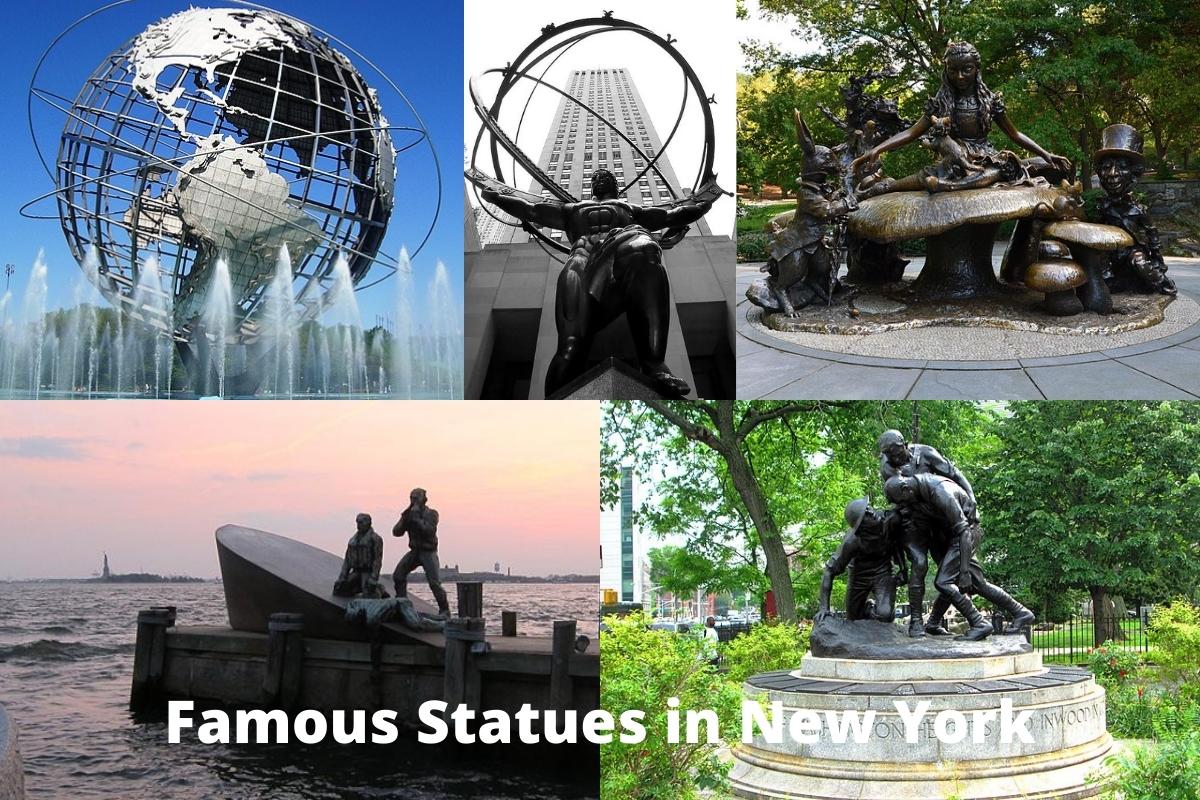New York has some of the finest statues and sculptures in the country with the city never shying away from commemorating or celebrating some of the biggest influences throughout it’s history.
The iconic Statue of Liberty is easily the most recognizable and is an icon that is famous the world over.
In this article, we will take a closer look at the 10 most famous statues in New York and examine the people that created them, as well as the reasons why they were made.
Famous Statues in New York
1. Statue of Liberty
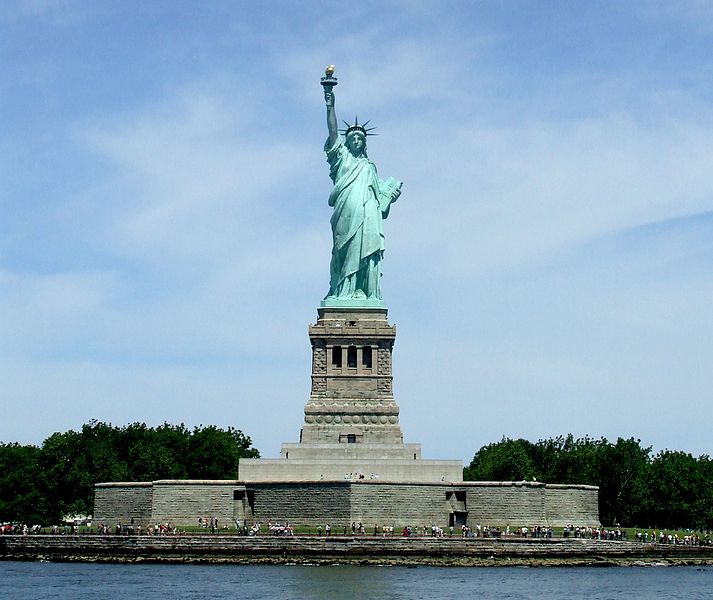
One of the world’s most iconic monuments sits in what was once the country’s most popular port city.
Statue of Liberty was consecrated in 1886 and put on Liberty Island off New York City’s shore.
It was erected by France and the US as a symbol of optimism for anybody entering the US from what was once a prominent immigration corridor.
The statue’s official name is Liberty Enlightening the World, but it’s often called the Statue of Liberty.
It stands 151 feet and 1 inch tall and overlooks the Atlantic Ocean in a region where many immigrants entered the nation in the late 19th and early 20th centuries.
The monument was conceived by French artist Frédéric Auguste Bartholdi, and Gustave Eiffel oversaw the construction. Lady Liberty is seen holding a torch and a tablet.
2. Charging Bull
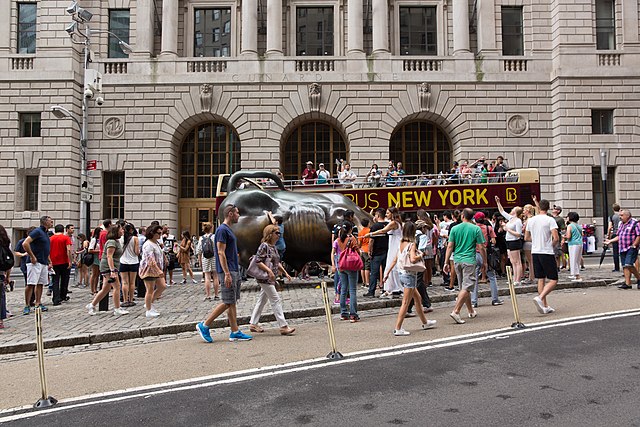
Charging Bull, also known as the Bull of Wall Street or the Bowling Green Bull, is a bronze sculpture located on Broadway just north of Bowling Green in Manhattan’s Financial District.
The bronze sculpture, which weighs 7,100 pounds (3,200 kg) and is 11 feet (3.4 m) tall and 16 feet (4.9 m) long, represents a bull, the emblem of strong financial optimism and wealth.
Charging Bull is a prominent tourist attraction that attracts thousands of visitors each day, representing Wall Street and the Financial District.
Arturo Di Modica, an Italian artist, created the sculpture in the aftermath of the 1987 Black Monday stock market disaster.
Di Modica landed on Wall Street late Thursday evening, December 14, 1989, with Charging Bull on the back of a truck and illegally placed the sculpture outside the New York Stock Exchange Building.
Charging Bull was placed in Bowling Green on December 20, 1989, after being removed by the New York City Police Department later that day. Despite having just a temporary authorization to operate in Bowling Green, Charging Bull quickly became a famous tourist attraction.
Di Modica may have been motivated by a pair of massive metallic sculptures, a charging bull and a bear, installed in front of the Frankfurt Stock Exchange in 1985 as part of the exchange’s 400th anniversary celebrations.
Following the popularity of the original sculpture, Di Modica developed a number of Charging Bull versions that were sold to private collectors.
3. Atlas
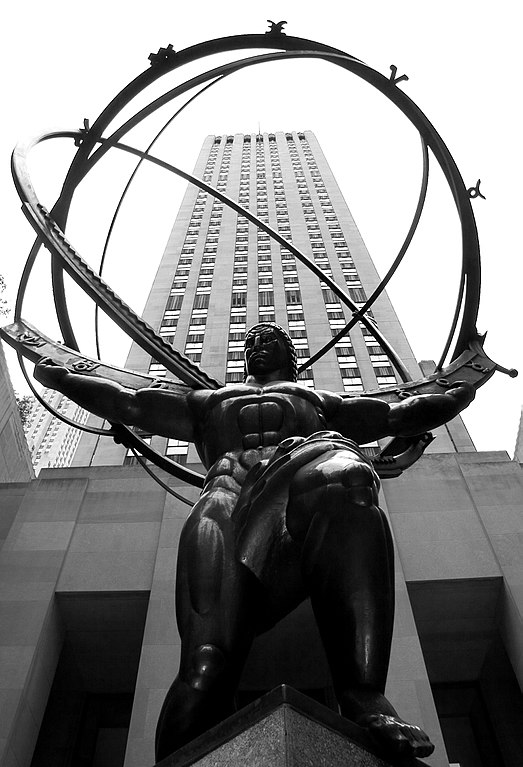
Atlas is a bronze monument located in Midtown Manhattan’s Rockefeller Center, near the International Building’s courtyard. It is located just across Fifth Avenue from St. Patrick’s Cathedral. Atlas, the ancient Greek Titan, is shown in the sculpture, supporting the heavens on his shoulders.
Atlas was designed by sculptor Lee Lawrie and erected in 1937 with the assistance of Rene Paul Chambellan.
Rockefeller Center’s sculpture is in the Art Deco style. The sculpture’s Atlas figure stands 15 feet (4.6 m) tall, while the complete statue is 45 feet (14 m) tall. It is the biggest sculpture in Rockefeller Center, weighing 7 short tons (6,400 kg).
Atlas is seen with the heavenly vault on his shoulders. The armillary sphere on his shoulders’ north-south axis points to the North Star’s location relative to New York City.
The statue is supported by one muscular leg on a modest stone pedestal with a corner facing Fifth Avenue.
Since then, the work has been adopted as a symbol of the Objectivist movement and has been linked to Ayn Rand’s book Atlas Shrugged.
4. Inwood Monument
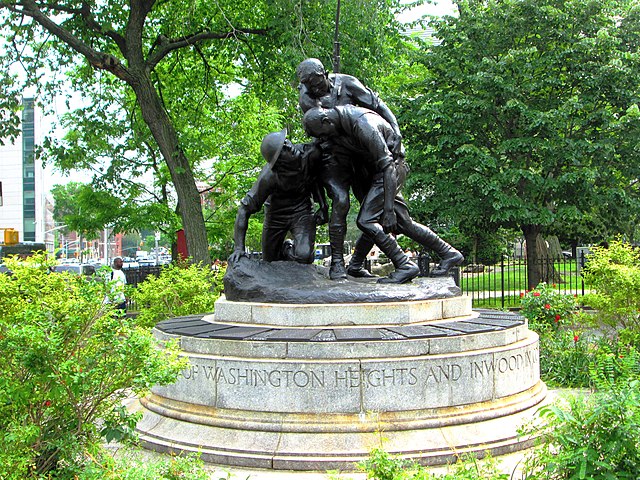
The Washington Heights-Inwood War Memorial, popularly known as the Inwood Monument, is a WWI memorial monument designed by Gertrude Vanderbilt Whitney and built by Albert Randolph Ross.
It is situated in Mitchel Square Park, New York City, New York, near the junction of Broadway and Saint Nicholas Avenue between 167th and 168th Streets.
On Memorial Day, May 30, 1922, the Inwood Monument was dedicated. It commemorates those who served and died during WWI from “the nearby neighborhoods in northern Manhattan of Washington Heights and Inwood.”
The memorial honors service members from three branches of the military: the Navy, the Army, and the Marine Corps.
5. The Sphere
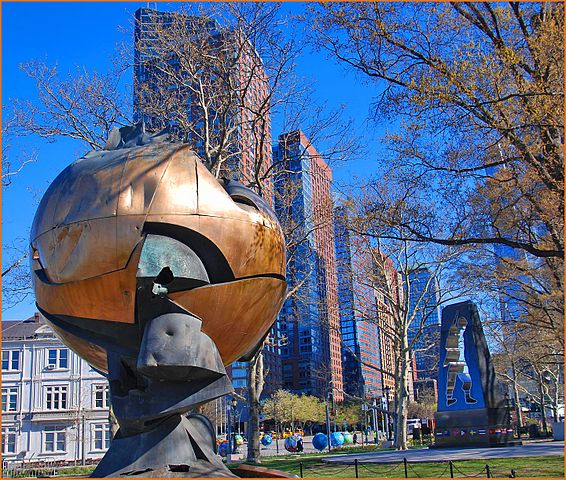
The Sphere (officially Große Kugelkaryatide N.Y., also known as Plaza Fountain Sphere, WTC Sphere, or Koenig Sphere) is a massive cast bronze sculpture by German artist Fritz Koenig.
From 1971 until the September 11, 2001, attacks, the world’s biggest bronze sculpture of modern times hung between the two buildings on the Austin J. Tobin Plaza of the World Trade Center in New York City.
Also Read: Famous Buildings in New York
The piece, weighing more than 20 tons, was the only mostly undamaged item of art rescued from the wreckage of the fallen twin buildings.
The artwork was the subject of the 2001 documentary Koenig’s Sphere after it was disassembled and housed near a hangar at John F. Kennedy International Airport.
The spherical caryatid was put at Battery Park from 2002 until 2017, when it was returned to its original site by the Port Authority of New York and New Jersey.
The sculpture, which had become a popular tourist attraction, was rededicated in its permanent site on August 16, 2017, despite the fact that it had not been renovated. The Sphere is located in Liberty Park, facing the 9/11 Memorial and its original position.
6. The Unisphere
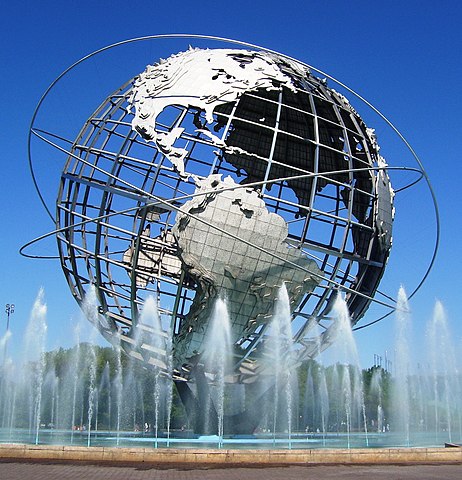
The Unisphere is a spherical stainless steel portrayal of Earth located in Flushing Meadows–Corona Park in the Queens borough of New York City. Gilmore D. Clarke created the globe as part of his idea for the 1964 New York World’s Fair.
The Unisphere was planned and built as the World’s Fair’s theme emblem to commemorate the advent of the space era. The World’s Fair theme was “Peace Through Understanding,” and the Unisphere reflected global interconnectedness by being devoted to “Man’s Achievements on a Shrinking Globe in an Expanding Universe.”
The Unisphere is 140 feet (43 meters) tall and 120 feet (37 meters) in circumference. It is supported by a 20-foot-tall (6.1-meter) tripod base with approximately 500 steel pieces symbolizing the continents and three steel rings representing the first artificial satellites circling Earth.
A reflecting pool 310 feet (94 meters) in diameter surrounds the Unisphere. The base is encircled by 48 pairs of fountainheads, which were designed to disguise the tripod that holds the globe.
Clarke came up with the idea for the Unisphere while flying in 1960. Clarke’s concept was accepted in early 1961 by New York City parks commissioner Robert Moses, who had previously rejected two ideas for iconic buildings for the 1964 World’s Fair.
From March through August 1963, American Bridge Company, a branch of US Steel, built the Unisphere after additional improvements. During the World’s Fair, almost 51 million people visited the Unisphere, which later became a permanent feature of Flushing Meadows–Corona Park.
The Unisphere was neglected in the 1970s and became noticeably filthy; it was repaired in the early 1990s. The Unisphere was declared a New York City landmark in 1995, and it was repaired in the early 2010s following another period of decay.
7. American Merchant Mariners’ Memorial
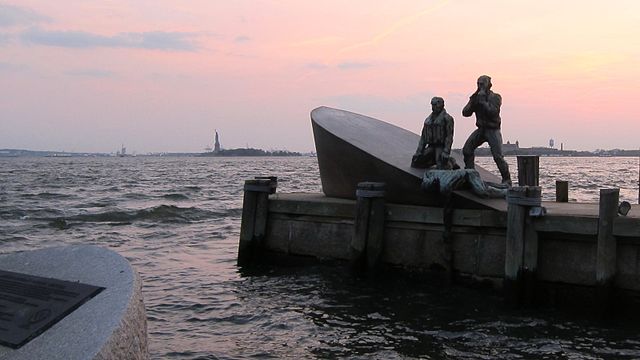
The American Merchant Mariners’ Memorial sculpture is placed west of the park in the Hudson River on a stone breakwater just south of Pier A and is linked to the pier via a dock.
Marisol Escobar designed it, and it was dedicated in 1991. During World War II, the bronze sculpture represents four merchant sailors with their sinking vessel after it was attacked by the German submarine U-123.
One of the seamen is in the water, and the sea is covering him with each high tide. The sculpture is largely based on an actual image of crewmen from the SS Muskogee taken by the U-captain, boat’s all of whom perished at sea.
The American Merchant Mariners’ Monument, Inc. commissioned the memorial.
8. Prometheus
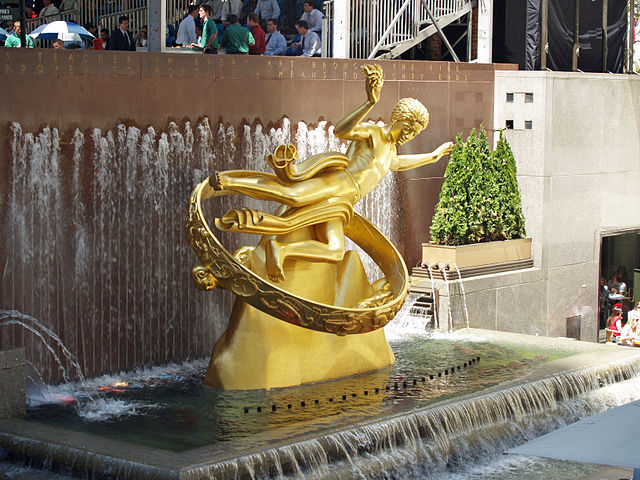
Paul Manship’s 1934 gilded, cast bronze sculpture Prometheus is located above the lower plaza at Rockefeller Center in Manhattan, New York. The monument was created by Roman Bronze Works in Queens and is 18 feet (5.5 meters) tall and weighs 8 tons.
It shows the Greek tale of Prometheus, the son of Titan Iapetus and Oceanid Clymene, who delivered fire to humanity by stealing it from the Chariot of the Sun, resulting in Zeus chaining Prometheus and sending an eagle to feast on his ever regenerating liver.
Prometheus is considered the complex’s major artwork and is one of its most well-known pieces of art. Every winter, the Rockefeller Center Christmas Tree is built over the monument.
Prometheus is the major visual lure of the lower plaza’s outdoor eatery the rest of the year.
9. General Sherman Statue
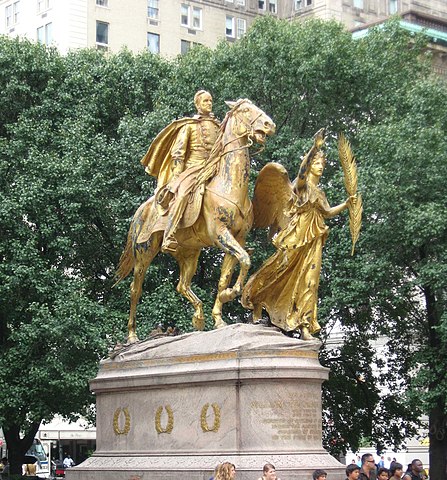
William Tecumseh Sherman, commonly known as the Sherman Memorial or Sherman Monument, is a sculptural group designed by Augustus Saint-Gaudens and placed in Grand Army Plaza in Manhattan, New York.
The gilded-bronze monument, which was cast in 1902 and dedicated on May 30, 1903, consists of an equestrian statue of Sherman and an attendant statue, Victory, an allegorical female figure of the Greek goddess Nike.
The sculptures are situated on a Stony Creek granite pedestal built by Charles Follen McKim.
10. Alice in Wonderland

Alice from Lewis Carroll’s famous 1865 novel Alice’s Adventures in Wonderland. The monument is placed on East 74th Street, on the north side of the Conservatory Water in Central Park.
Alice is seen perched on a big mushroom, grasping for the White Rabbit’s pocket watch. The Cheshire Cat is peering over her shoulder, flanked on one side by the Dormouse and on the other by the Mad Hatter, who, in contrast to the placid Alice, seems ready to burst out laughing at any minute.
George T. Delacorte Jr., a publisher and philanthropist, commissioned the sculpture from José de Creeft in memory of Delacorte’s late wife, Margarita, and for the delight of New York’s children.
De Creeft’s sculpture, which was unveiled in 1959, attempts to replicate John Tenniel’s fanciful Victorian images from the first edition of the book. According to numerous reports, Alice resembles de Creeft’s daughter Donna.
Hideo Sasaki and Fernando Texidor, the architects and designers of the Alice in Wonderland project, put plaques with inscriptions from the book on the terrace surrounding the sculpture.

